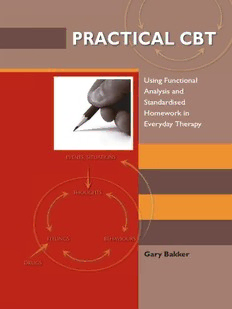Table Of ContentP
R
A
C
PRACTICAL CBT
T
I
C
A
L
C
B
T Using Functional
It is the clinician’s task to take what we know works and
to tailor it to the person seeking help. Successfully ‘selling’
Analysis and
this therapeutic model to the client relies on clearly
explaining what is happening and reinforcing session Standardised
achievements with effective change-directed homework.
Homework in
Practical CBT is designed for a range of mental health
professionals who have a basic grounding in learning theory
Everyday Therapy
and cognitive–behaviour therapy but want to know how
best to apply it in their day-to-day practice.
The book provides explicit assessment-to-treatment
pathways with links to over 45 tried and tested ready-to-use
homework scripts covering a range of common therapy
issues including self-monitoring, self-esteem, decision-
making, depression, anxiety, sleep, and anger. The author
is a highly experienced clinician with a firm adherence
to the scientist–practitioner model and the use of
evidence-based protocols.
Gary Bakkeris a clinical psychologist with 28 years
of experience working with children, adolescents, adults,
couples, and families in clinics, hospitals, community centres,
and for 20 years in private practice. He trained in CBT
when it was newly emerging as the evidence-based therapy
of choice, receiving the Fiona Allen Prize during his masters
program. Gary has since given innumerable seminars and
workshops on themes in CBT, all the while honing its
presentation, clarity, and acceptability for his clients,
resulting in the verbatim suggested scripts that comprise
much of this book. He has bridged the gap between G Gary Bakker
attention to the psychotherapy process and outcome A
research, and the demands of practical real-world therapy. R
Y
B
A
K
K
E
R
PRACTICAL CBT
Using Functional Analysis
and Standardised Homework
in Everyday Therapy
Gary Bakker
First published in 2008 by
Australian Academic Press Pty Ltd
32 Jeays Street
Bowen Hills QLD 4006
Australia
www.australianacademicpress.com.au
Copyright © 2008 Gary Bakker
Reproduction and communication for academic purposes:
The Australian Copyright Act 1968 (Cwlth) allows a maximum of one chapter or 10% of the pages of this work,
whichever is the greater, to be reproduced and/or communicated by any educational institution for its educational pur-
poses provided that the educational institution (or the body that administers it) has given a remuneration notice to
Copyright Agency Limited (CAL) under the Act.
For details of the CAL licence for educational institutions contact:
Copyright Agency Limited
Level 19, 157 Liverpool Street
Sydney NSW 2000
Telephone: (02) 9394 7600
Facsimile: (02) 9394 7601
E-mail: [email protected]
Reproduction and communication for other purposes:
Except as permitted under the Act (for example, a fair dealing for the purposes of study, research, criticism or review)
no part of this book may be reproduced, stored in a retrieval system, communicated or transmitted in any form or by
any means without prior written permission. All inquiries should be made to the publisher at the address above.
National Library of Australia
Cataloguing-in-Publication Data:
Author: Bakker, Gary.
Title: Practical CBT : using functional analysis,
problem-maintaining-circles, and standardised homework
in everyday therapy / Gary Bakker.
Edition: 1st ed.
ISBN: ebook 9781921513176
Subjects: Cognitive therapy--Handbooks, manuals, etc.
Behavior modification--Handbooks, manuals, etc.
Behavioral assessment.
Dewey Number: 616.891425
DISCLAIMER: Every effort has been made in preparing this work to provide information based on accepted
standards and practice at the time of publication. The publisher, however, makes no warranties of any kind of
psychological outcome relating to use of this work and disclaims all responsibility or liability for direct or
consequential damages resulting from any use of the material contained in this work.
Contents
Acknowledgments..............................................................................................................................vii
Section 1
Chapter 1
Introduction ....................................................................................................................................3
Chapter 2
Why CBT?........................................................................................................................................5
Chapter 3
A CBT Model................................................................................................................................11
Section 2
Chapter 4
The Initial Assessment ................................................................................................................23
Chapter 5
Assessment-To-Treatment Decision Pathways......................................................................35
Section 3 – Homework Prescriptions
■SELF-MONITORING
Homework 1
Negative Emotion Records (NERs)..........................................................................................47
Homework 2
NERs + Coping Options ............................................................................................................52
Homework 3
NERs + Thinking Errors..............................................................................................................55
Homework 4
Challenge Diary............................................................................................................................57
Homework 5
Social Challenge Diary................................................................................................................59
■SELF-ESTEEM, ASSERTIVENESS, SELF-EFFICACY
Homework 6
25 Positives....................................................................................................................................60
Homework 7
Socialisation Messages ................................................................................................................63
Contents iii
■SELF-ESTEEM, ASSERTIVENESS, SELF-EFFICACY (continued)
Homework 8
Testimonials....................................................................................................................................66
Homework 9
Personal Rights Listing ................................................................................................................67
Homework 10
‘I’ Statements ................................................................................................................................69
Homework 11
Positive Assertiveness..................................................................................................................70
Homework 12
Locus of Control Speech Correction......................................................................................71
■SELF-ORGANISATION/DECISION-MAKING
Homework 13
Options Clarification ..................................................................................................................73
Homework 14
Decisions Book ............................................................................................................................74
Homework 15
Values Ordering/Priorities Clarification..................................................................................77
Homework 16
Values Into Goals..........................................................................................................................80
Homework 17
Goals Into Plans............................................................................................................................81
Homework 18
Self-Organisation..........................................................................................................................82
Homework 19
15-Minute Time Slots ..................................................................................................................84
Homework 20
Achievement Recording..............................................................................................................85
■DEPRESSION MANAGEMENT
Homework 21
Pleasant Events Schedule (PES) ................................................................................................86
–HANDOUT 1: Pleasant Events Schedule Self-Assessment
Homework 22
PES Sublist....................................................................................................................................100
Homework 23
PES Diary......................................................................................................................................101
Homework 24
Regular Exercise..........................................................................................................................103
Homework 25
Overwhelming Sensory Experiences ....................................................................................105
iv Contents
■DEPRESSION MANAGEMENT (continued)
Homework 26
Options When Suicidal..............................................................................................................107
Homework 27
Graze Foods................................................................................................................................108
■SLEEP
Homework 28
Sleep Hygiene..............................................................................................................................109
Homework 29
Dream Antidotes........................................................................................................................113
■ANXIETY MANAGEMENT
Homework 30
Worry Questions ......................................................................................................................115
Homework 31
Allocating Worry Time..............................................................................................................118
Homework 32
Relaxation Sessions....................................................................................................................120
Homework 33
Mini-Relaxers..............................................................................................................................122
Homework 34
Subjective Units of Distress (SUDS) of 7 ............................................................................125
Homework 35
Reasonable Versus Unreasonable Worries Listing..............................................................126
Homework 36
Thought-Stopping......................................................................................................................127
Homework 37
Social Phobia Self-Statements..................................................................................................130
Homework 38
Over-Breathing Experiment ....................................................................................................132
–HANDOUT 2: HV Questionnaire (Over-Breathing)
Homework 39
Caffeine Reduction....................................................................................................................135
■ANGER MANAGEMENT
Homework 40
Angry Self-Talk............................................................................................................................137
Homework 41
Time-Outs....................................................................................................................................139
Contents v
■SITUATIONAL FACTORS
Homework 42
Life Change Units ......................................................................................................................140
–HANDOUT 3: Recent Life Changes Questionnaire
Homework 43
Reasons To Change....................................................................................................................144
Section 4 – Scripts
Script 1
Self-Efficacy, Self-Esteem Restoration ........................................................................................149
Script 2
Introducing the CBT Model..........................................................................................................151
Script 3
Individualised PMCs........................................................................................................................153
Script 4
Common or Expected Prognosis................................................................................................154
Script 5
Not Just ‘Talk Therapy’ ..................................................................................................................157
Script 6
Education About Normal Anxiety, Grief, and Trauma Reactions..........................................159
References........................................................................................................................................161
vi Contents
Acknowledgments
Sincere thanks and gratitude go to my early clinical inspirations:
To Iain Montgomery, who encouraged me to respect the evidence.
To John Warren, who encouraged me to use my common sense.
And to Michael Griffin, who encouraged me to try to genuinely connect with my clients.
And to Michelle, who magically turned scrawl into manuscript.
Acknowledgments vii
SECTION 1
Introduction
Why CBT?
A CBT Model

